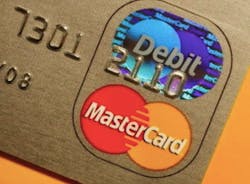Mastercard, MatchMove and Idemia to pilot fingerprint biometric card in Asia
Oct. 26—SINGAPORE — Keying in a personal identification numbers (PIN) or signing a credit card bill may be a thing of the past if consumers take to a biometric card that uses fingerprint authorisation instead.
Mastercard has partnered augmented identity firm Idemia and Singapore-based fintech startup MatchMove to pilot this card in Asia.
The F.Code Easy card will make transactions more convenient and secure, and reduce touch points in public places, said the companies on Wednesday (Oct 21).
Biometric credentials are stored on a chip on the card, and not a central database, for improved privacy and security.
The battery-free card harvests energy from payment terminals to power its fingerprint sensor and is ISO-certified by Mastercard for security and compliance. It was developed by Idemia in line with Mastercard's specifications.
Digital payments start-up MatchMove will issue 200 to 500 biometric cards to employees of Mastercard, Idemia and MatchMove in the fourth quarter of this year. They will use the cards for transactions and live demonstrations during the pilot run.
MatchMove told The Straits Times that it is targeting a take-up of 2,000 to 3,000 F.Code Easy cards in Singapore next year. The firm is part of a consortium that has submitted an application for a digital full bank licence to the Monetary Authority of Singapore.
Mastercard said the pilot will involve prepaid cards, but F.Code Easy could be used for any credit, debit or prepaid programme.
The biometric card can also be used at ATMs outside Singapore. It can be used at all point-of-sale terminals that accept Mastercard-branded cards.
A Mastercard spokesman said: "For merchants, no hardware changes are necessary and the POS terminal infrastructure does not require any modifications or upgrades."
Cardholders receive their cards together with a battery-operated enrolment device, which securely and conveniently stores their fingerprint templates on the card. Once this is done, the card is biometrically activated.
When shopping and paying in-store, the cardholder simply taps or inserts the card at the retailer's payment terminal while placing a finger on the embedded sensor. The fingerprint is verified against the stored fingerprint template on the card and if the biometrics match, the cardholder can be successfully authenticated and the transaction approved.
___
(c)2020 the Asia News Network (Hamburg, Germany)
Visit the Asia News Network (Hamburg, Germany) at www.asianewsnet.net/home/
Distributed by Tribune Content Agency, LLC.


